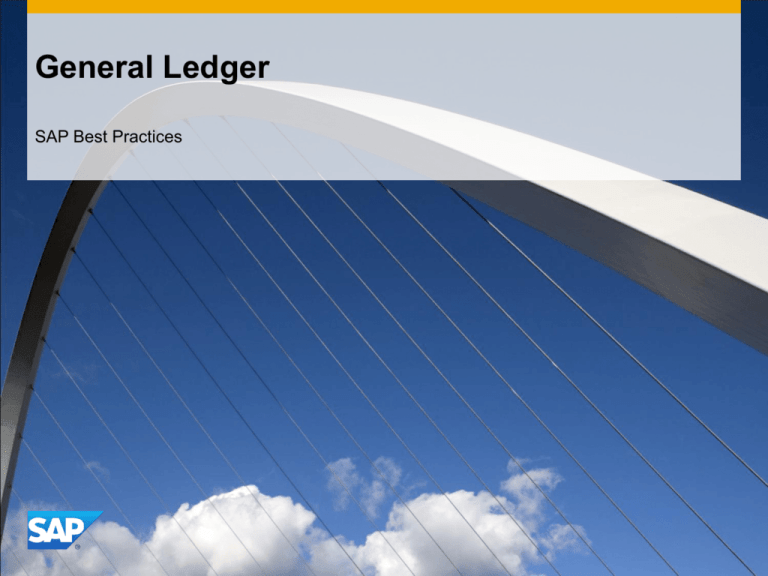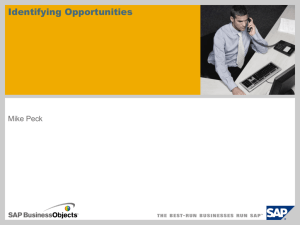
General Ledger
SAP Best Practices
Purpose, Benefits, and Key Process Steps
Purpose
This scenario provides a comprehensive picture of external accounting and accounts.
Benefits
Recording all business transaction ensures complete and accurate accounting data.
Key Process Steps
Posting General Ledger Account Documents
Displaying the Document Journal
Displaying G/L Balances (List)
Carrying Out Recurring Entries
Account Maintenance: Automatic and Manual Clearing
© 2014 SAP SE or an SAP affiliate company. All rights reserved.
2
Required SAP Applications and Company Roles
Required
Enhancement package 7 for SAP ERP 6.0
Company Roles
General Ledger Accountant
Finance Manager
© 2014 SAP SE or an SAP affiliate company. All rights reserved.
3
Detailed Process Description
General Ledger
The central task of G/L accounting is to provide a comprehensive picture of external
accounting and accounts. Recording all business transactions (primary postings as well as
settlements from internal accounting) in a software system that is fully integrated with all
the other operational areas of a company ensures that the accounting data is always
complete and accurate.
The SAP FI General Ledger has the following features:
– Free choice of level: corporate group or company
– Automatic and simultaneous posting of all sub-ledger items in the appropriate general ledger accounts
(reconciliation accounts)
– Simultaneous updating of general ledger and cost accounting areas
– Real-time evaluation of and reporting on current accounting data, in the form of account displays,
financial statements with different financial statement versions and additional analyses.
Essentially, the general ledger serves as a complete record of all business transactions. It
is the centralized, up-to-date reference for the rendering of accounts. Actual individual
transactions can be checked at any time in realtime processing by displaying the original
documents, line items, and transaction figures at various levels such as:
–
–
–
–
Account information
Journals
Totals/transaction figures
Balance sheet/profit and loss evaluations
© 2014 SAP SE or an SAP affiliate company. All rights reserved.
4
Process Flow Diagram
Posting (FI)
Finance Manager
General Ledger Accountant
Event
General Ledger
Displaying
and Change
Displaying
Process
Decision
Reversal
Clearing
Process
Decision
Process
Decision
Display
Document
Compact
Journal
Document
Display /
Change Line
Items
GL Account
Balances New
Individual
Reverse
Display
Balance New
Post G/L
Accounting
Document
Display
Document
Journal
Recurring
Document
Account
Clearing
Automatic
Clearing
Mass Reverse
Recurring
Documents
List
Execute
Recurring
Entries
© 2014 SAP SE or an SAP affiliate company. All rights reserved.
5
Legend
<Function>
Symbol
Description
Usage Comments
Band: Identifies a user role, such as Accounts
Payable Clerk or Sales Representative. This band
can also identify an organization unit or group,
rather than a specific role.
Role band contains
tasks common to that
role.
Symbol
Diagram
Connection
The other process flow symbols in this table go
into these rows. You have as many rows as
required to cover all of the roles in the scenario.
External
to SAP
External Events: Contains events that start or end
the scenario, or influence the course of events in
the scenario.
Business
Activity / Event
SubProcess
Reference
Process
Decision
Flow line (solid): Line indicates the normal sequence
of steps and direction of flow in the scenario.
Flow line (dashed): Line indicates flow to
infrequently-used or conditional tasks in a
scenario. Line can also lead to documents involved
in the process flow.
Connects two tasks in
a scenario process or
a non-step event
Business Activity / Event: Identifies an action that
either leads into or out of the scenario, or an
outside Process that happens during the scenario
Does not correspond
to a task step in the
document
Unit Process: Identifies a task that is covered in a
step-by-step manner in the scenario
Corresponds to a task
step in the document
To next / From last Diagram: Leads
to the next / previous page of the
Diagram
Flow chart continues on the next /
previous page
Hardcopy / Document: Identifies a
printed document, report, or form
Does not correspond to a task
step in a document; instead, it is
used to reflect a document
generated by a task step; this
shape does not have any outgoing
flow lines
Financial Actuals: Indicates a
financial posting document
Does not correspond to a task
step in a document; instead, it is
used to reflect a document
generated by a task step; this
shape does not have any outgoing
flow lines
Budget Planning: Indicates a
budget planning document
Does not correspond to a task
step in a document; instead, it is
used to reflect a document
generated by a task step; this
shape does not have any outgoing
flow lines
Manual Process: Covers a task
that is manually done
Does not generally correspond to
a task step in a document;
instead, it is used to reflect a task
that is manually performed, such
as unloading a truck in the
warehouse, which affects the
process flow.
Existing Version / Data: This block
covers data that feeds in from an
external process
Does not generally correspond to
a task step in a document;
instead, this shape reflects data
coming from an external source;
this step does not have any
incoming flow lines
System Pass / Fail Decision: This
block covers an automatic
decision made by the software
Does not generally correspond to
a task step in the document;
instead it is used to reflect an
automatic decision by the system
that is made after a step has been
executed.
Financial
Actuals
Process Reference: If the scenario references
another scenario in total, put the scenario number
and name here.
Corresponds to a task
step in the document
Sub-Process Reference: If the scenario references
another scenario in part, put the scenario number,
name, and the step numbers from that scenario
here
Corresponds to a task
step in the document
Process Decision: Identifies a decision / branching
point, signifying a choice to be made by the end
user. Lines represent different choices emerging
from different parts of the diamond.
Does not usually
correspond to a task
step in the document;
Reflects a choice to
be made after step
execution
© 2014 SAP SE or an SAP affiliate company. All rights reserved.
Usage Comments
Hardcopy /
Document
Budget
Planning
Unit Process
Process
Reference
Description
Manual
Process
Existing
Version /
Data
System
Pass/Fail
Decision
6
© 2014 SAP SE or an SAP affiliate company. All rights reserved.
No part of this publication may be reproduced or transmitted in any form or for any purpose without the express permission of SAP SE or an
SAP affiliate company.
SAP and other SAP products and services mentioned herein as well as their respective logos are trademarks or registered trademarks of SAP SE
(or an SAP affiliate company) in Germany and other countries. Please see http://global12.sap.com/corporate-en/legal/copyright/index.epx for additional
trademark information and notices.
Some software products marketed by SAP SE and its distributors contain proprietary software components of other software vendors.
National product specifications may vary.
These materials are provided by SAP SE or an SAP affiliate company for informational purposes only, without representation or warranty of any kind,
and SAP SE or its affiliated companies shall not be liable for errors or omissions with respect to the materials. The only warranties for SAP SE or
SAP affiliate company products and services are those that are set forth in the express warranty statements accompanying such products and
services, if any. Nothing herein should be construed as constituting an additional warranty.
In particular, SAP SE or its affiliated companies have no obligation to pursue any course of business outlined in this document or any related
presentation, or to develop or release any functionality mentioned therein. This document, or any related presentation, and SAP SE’s or its affiliated
companies’ strategy and possible future developments, products, and/or platform directions and functionality are all subject to change and may be
changed by SAP SE or its affiliated companies at any time for any reason without notice. The information in this document is not a commitment,
promise, or legal obligation to deliver any material, code, or functionality. All forward-looking statements are subject to various risks and uncertainties
that could cause actual results to differ materially from expectations. Readers are cautioned not to place undue reliance on these forward-looking
statements, which speak only as of their dates, and they should not be relied upon in making purchasing decisions.
© 2014 SAP SE or an SAP affiliate company. All rights reserved.
7








